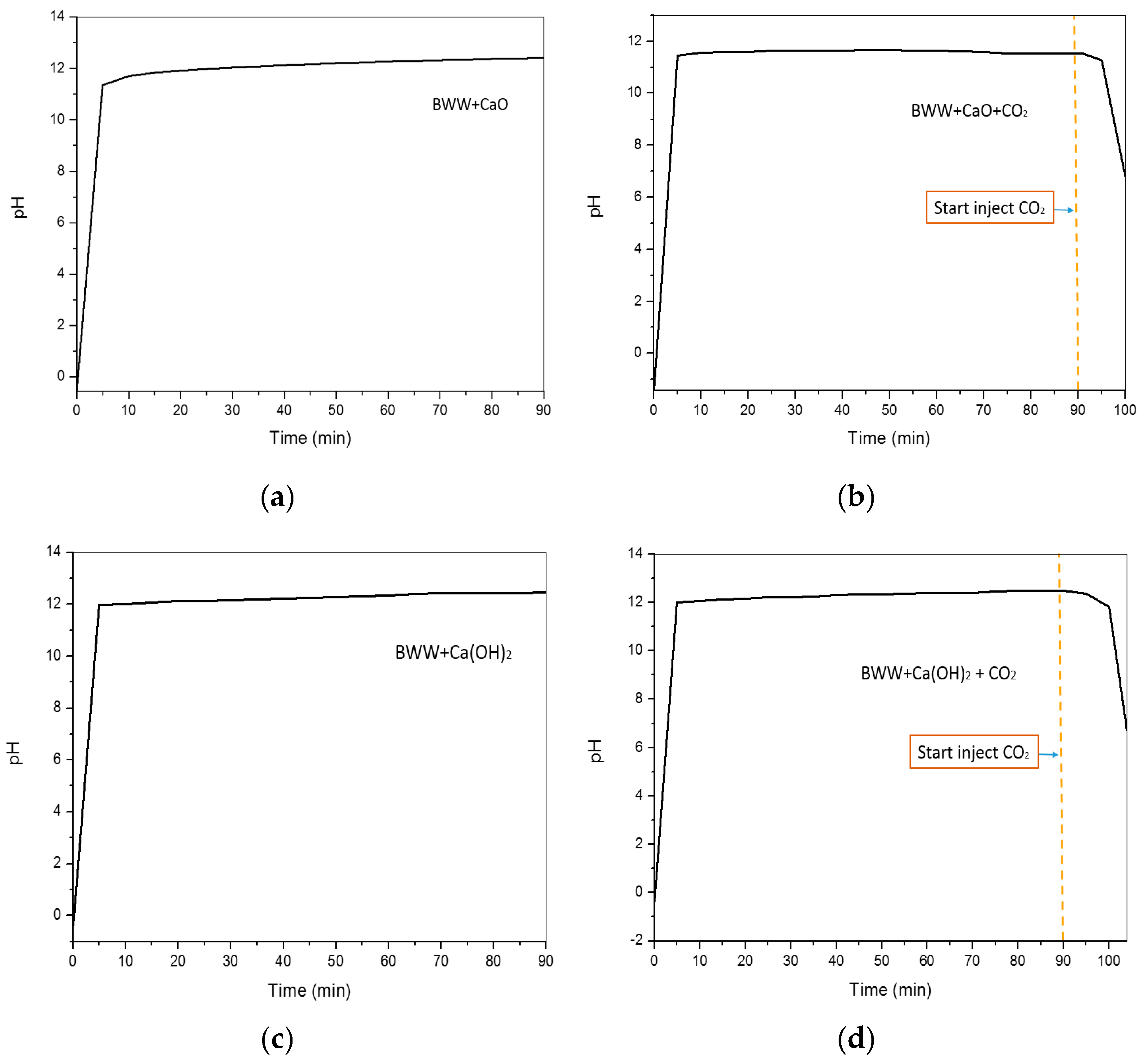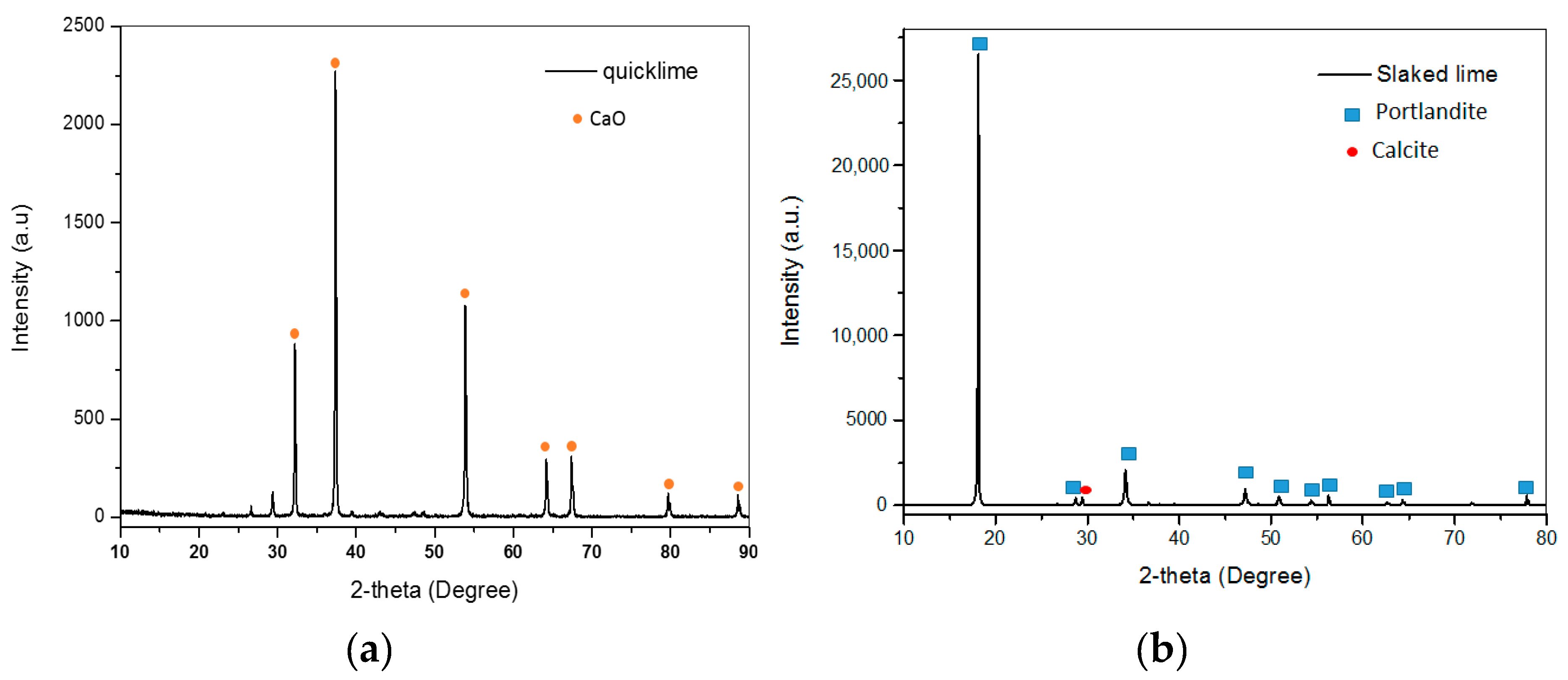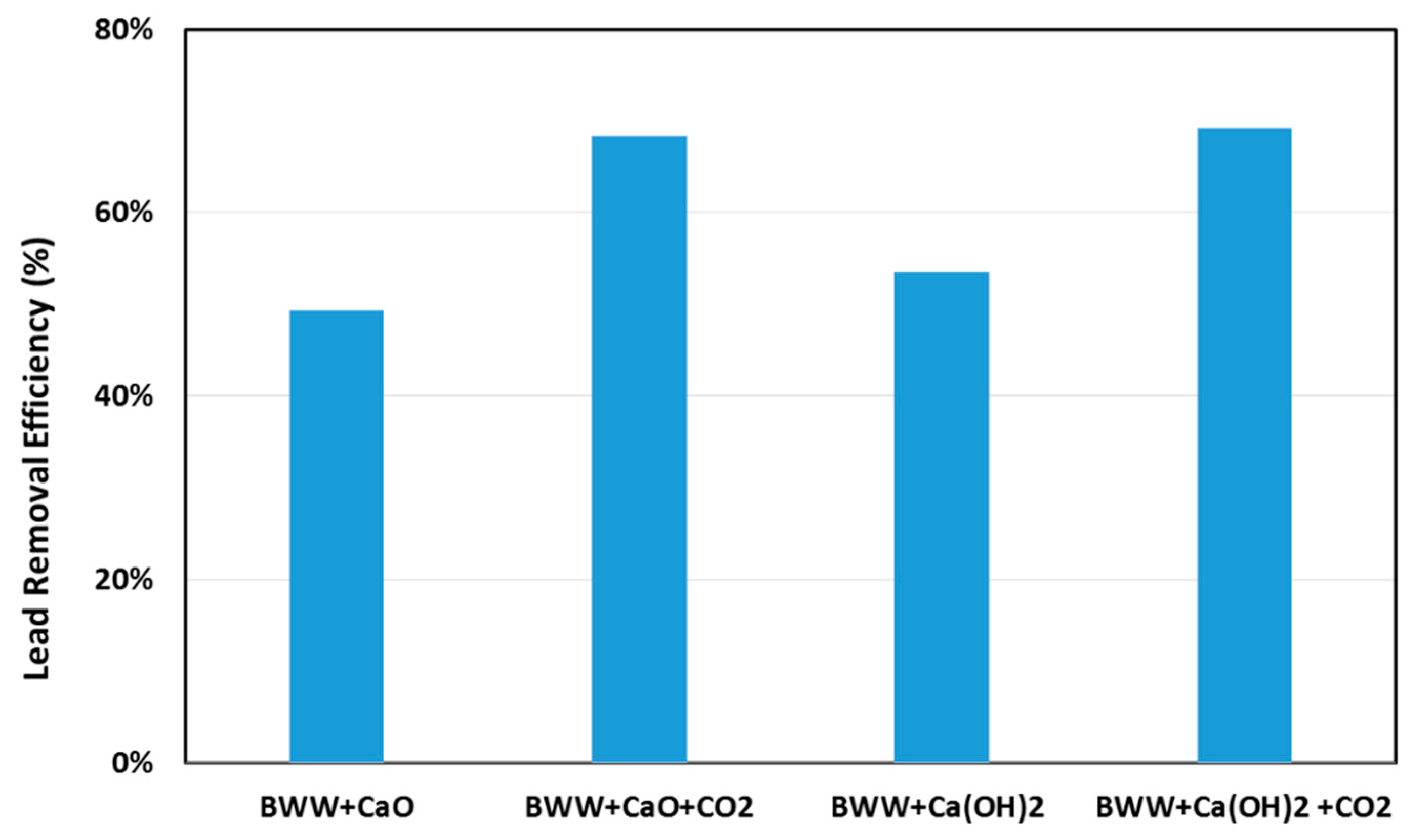Sustainable Treatment for Sulfate and Lead Removal from Battery Wastewater
Abstract
:1. Introduction
2. Materials and Method
2.1. Materials
2.2. Experiment
2.3. Physical Characterization
3. Results and Discussion
4. Conclusions
Author Contributions
Acknowledgments
Conflicts of Interest
References
- Murariu, T.; Morari, C. Time-dependent analysis of the state-of-health for lead-acid batteries: An EIS study. J. Energy Storage 2019, 21, 87–93. [Google Scholar] [CrossRef]
- Iwai, T.; Murakami, M.; Takai, S.; Yabutsuka, T.; Yao, T. Chemical transformation of PbO2 due to local cell reaction on the cathode of lead acid battery. J. Alloy. Compd. 2019, 780, 85–89. [Google Scholar] [CrossRef]
- May, J.G.; Davidson, A.; Monahov, B. Lead batteries for utility energy storage: A review. J. Energy Storage 2018, 15, 145–157. [Google Scholar] [CrossRef]
- Karden, E. Development trends for future automobiles and their demand on the battery. In Lead-acid Batteries for Future Automobiles; Garche, J., Karden, E., Moseley, P.T., Rand, D.A., Eds.; Elsevier Science: Aachen, Germany, 2017; pp. 3–25. [Google Scholar]
- Cooper, A. Development of a high-performance lead-acid battery for new-generation vehicles. J. Power. Sour. 2005, 144, 385–394. [Google Scholar] [CrossRef]
- Ambrose, H.; Gershenson, D.; Gershenson, A.; Kammen, D. Driving rural energy access: A second-life application for electric-vehicle batteries. Environ. Res. Lett. 2014, 9, 1–9. [Google Scholar] [CrossRef]
- Wagner, R. Stationary application. I. Lead-acid batteries for telecommunication and UPS. In Industrial Application of Batteries; Broussely, M., Pistoia, G., Eds.; Elsevier Science: Amsterdam, The Netherlands, 2007; pp. 395–454. [Google Scholar]
- Sun, Z.; Cao, H.; Zhang, X.; Lin, X.; Zheng, W.; Cao, G.; Sun, Y.; Zhang, Y. Spent lead acid battery recycling in China- A review and sustainable analyses on mass flow of lead. Waste. Manag. 2017, 64, 190–201. [Google Scholar] [CrossRef]
- Sheng, P.X.; Ting, Y.P.; Chen, J.P.; Hong, L. Sorption of lead, copper, cadmium, zinc, and nickel by marine algal biomass: characterization of biosorptive capacity and investigation of mechanisms. J. Coll. Interface Sci. 2004, 275, 131–141. [Google Scholar] [CrossRef] [PubMed]
- Drinking Water Contaminants—Standard and Regualtions. Available online: http://water.epa.gov/drink/contaminants/index.cfm#Inorganic (accessed on 30 January 2012).
- Khaoya, S.; Pancharoen, U. Removal of Lead (II) from industry wastewater by HFSLM. Int. J. Chem. Eng. Appl. 2012, 3, 98–103. [Google Scholar] [CrossRef]
- WHO. Guidelines for Drinking-water Quality; World Health Organization: Geneva, Switzerland, 2011. [Google Scholar]
- Silva, A.M.; Lima, R.; Leão, V.A. Mine water treatment with limestone for sulphate removal. J. Hazard. Mater. 2012, 221–222, 45–55. [Google Scholar]
- Petruzzelli, D.; Pagano, M.; Tiravanti, G.; Passino, R. Lead removal and recovery from battery wastewaters by natural zeolite clinoptilolite. Solv. Extr. Ion Exc. 1999, 17, 677–694. [Google Scholar] [CrossRef]
- Dabrowski, A.; Hubicki, Z.; Podkoscielny, P.; Robens, E. Selective removal of the heavy metal ions from waters and industrial wastewaters by ion-exchange method. Chemosphere 2004, 56, 91–106. [Google Scholar] [CrossRef] [PubMed]
- Guimarães, D.; Leão, V.A. Batch and fixed-bed assessment of sulphate removal by the weak base ion exchange resin Amberlyst A21. J. Hazard. Mater. 2014, 280, 209–215. [Google Scholar] [CrossRef] [Green Version]
- Lin, S.W.; Navarro, R.M.F. An innovative method for removing Hg2+ and Pb2+ in ppm concentrations from aqueous media. Chemosphere 1999, 39, 1809–1817. [Google Scholar] [CrossRef]
- Acharya, J.; Sahu, J.N.; Mohanty, C.R.; Meikap, B.C. Removal of lead(II) from wastewater by activated carbon developed from Tamarind wood by zinc chloride activation. Chem. Eng. J. 2009, 149, 249–262. [Google Scholar] [CrossRef]
- Singh, C.K.; Sahu, J.N.; Mahalik, K.K.; Mohanty, C.R. Studies on the removal of Pb(II) from wastewater by activated carbon developed from Tamarind wood activated with sulphuric acid. J. Hazard. Mater. 2008, 153, 221–228. [Google Scholar] [CrossRef]
- Saeed, A.; Iqbal, M.; Akhtar, M.W. Removal and recovery of lead (II) from single and multimetal (Cd, Cu, Ni,Zn) solutions by crop milling waste (black gram husk). J. Hazard. Mater. 2005, 117, 65–73. [Google Scholar] [CrossRef]
- Gunay, A.; Arslankaya, E.; Tosun, I. Lead removal from aqueous solution by natural and pretreated clinoptilolite: Adsorptionequilibrium and kinetics. J. Hazard. Mater. 2007, 146, 362–371. [Google Scholar] [CrossRef] [PubMed]
- Doyurum, S.; Celik, A. Pb(II) and Cd(II) removal from aqueous solutions by olive cake. J. Hazard. Mater. 2006, 138, 22–28. [Google Scholar] [CrossRef] [PubMed]
- Runtti, H.; Luukkonen, T.; Niskanen, M.; Tuomikoski, S.; Kangas, T.; Tynjälä, P.; Tolonen, E.T.; Sarkkinen, M.; Kemppainen, K.; Rämö, J. Sulphate removal over barium-modified blast-furnace-slag geopolymer. J. Hazard. Mater. 2016, 317, 373–384. [Google Scholar] [CrossRef] [PubMed] [Green Version]
- Bader, M.S. Separation of chloride and sulphate ions in univalent and divalent cation forms from aqueous streams. J. Hazard. Mater. 2000, 73, 269–283. [Google Scholar] [CrossRef]
- Chen, Q.; Yao, Y.; Li, X.; Lu, J.; Zhou, J.; Huang, Z. Comparison of heavy metal removals from aqueous solution by chemical precipitation and characteristics of precipitates. J. Water Process Eng. 2018, 26, 289–300. [Google Scholar] [CrossRef]
- Mahmood, M.B.; Balasim, A.A.; Najab, M.A. Removal of heavy metals using chemicals precipitation. Eng. Technol. J. 2011, 29, 1–18. [Google Scholar]
- Mallampati, R.; Valiyaveettil, S. Co-precipitation with calcium carbonate—a fast and nontoxic method for removal of nanopollutants from water? RSC Adv. 2015, 5, 11023–11028. [Google Scholar] [CrossRef]
- Azimi, A.; Azari, A.; Rezakazemi, M.; Ansarpour, M. Removal of heavy metals from industrial wastewaters: A review. Chem. Bio. Eng. Rev. 2017, 4, 1–24. [Google Scholar] [CrossRef]
- Vu, H.H.T.; Khan, M.D.; Chilakala, R.; Lai, T.Q.; Thenepalli, T.; Ahn, J.W.; Park, D.U.; Kim, J. Utilization of lime mud waste from paper mills for efficient phosphorus removal. Sustainability 2019, 11, 1524. [Google Scholar] [CrossRef]
- Khan, M.D.; Ahn, J.W.; Nam, G. Environmental benign synthesis, characterization and mechanism studies of green calcium hydroxide nano-plates derived from waste oyster shells. J. Environ. Manag. 2018, 223, 947–951. [Google Scholar] [CrossRef]




| Compound Name | SiO2 | Al2O3 | Fe2O3 | CaO | MgO | K2O | Na2O | TiO2 | MnO | P2O5 | Ig.Loss |
|---|---|---|---|---|---|---|---|---|---|---|---|
| Quicklime (CaO) | 1.98 | 0.31 | 0.38 | 91.25 | 1.27 | 0.05 | <0.02 | 0.02 | 0.02 | 0.01 | 4.75 |
| Slaked lime Ca(OH)2 | 1.84 | 0.33 | 0.40 | 66.63 | 3.36 | 0.08 | <0.02 | 0.02 | 0.02 | 0.02 | 26.96 |
| Parameter | Value |
|---|---|
| Sulfate (mg/L) | 147,000 |
| Lead (mg/L) | 3.01 |
| pH | −0.52 |
| Experiment | Lead Removal Efficiency |
|---|---|
| BWW + CaO | 49.3% |
| BWW + CaO + CO2 | 68.4% |
| BWW + Ca(OH)2 | 53.5% |
| BWW + Ca(OH)2 + CO2 | 69.3% |
© 2019 by the authors. Licensee MDPI, Basel, Switzerland. This article is an open access article distributed under the terms and conditions of the Creative Commons Attribution (CC BY) license (http://creativecommons.org/licenses/by/4.0/).
Share and Cite
Vu, H.H.T.; Gu, S.; Thriveni, T.; Khan, M.D.; Tuan, L.Q.; Ahn, J.W. Sustainable Treatment for Sulfate and Lead Removal from Battery Wastewater. Sustainability 2019, 11, 3497. https://doi.org/10.3390/su11133497
Vu HHT, Gu S, Thriveni T, Khan MD, Tuan LQ, Ahn JW. Sustainable Treatment for Sulfate and Lead Removal from Battery Wastewater. Sustainability. 2019; 11(13):3497. https://doi.org/10.3390/su11133497
Chicago/Turabian StyleVu, Hong Ha Thi, Shuai Gu, Thenepalli Thriveni, Mohd Danish Khan, Lai Quang Tuan, and Ji Whan Ahn. 2019. "Sustainable Treatment for Sulfate and Lead Removal from Battery Wastewater" Sustainability 11, no. 13: 3497. https://doi.org/10.3390/su11133497





